INSTRUCTION MANUAL
DW310, DW311
VS RECIPROCATING SAWS
DEWALT Industrial Tool Co.,
701 East Joppa Road, Baltimore, MD 21286 • 20 Fletcher Road, Mooroolbark, VIC 3138 Australia
(FEB06) Form No. 635606-00 DW310-XE, DW311-XE Copyright © 2006 D
EWALT
The following are trademarks for one or more D
EWALT power tools: the yellow and black color scheme; the “D” shaped
air intake grill; the array of pyramids on the handgrip; the kit box configuration; and the array of lozenge-shaped humps
on the surface of the tool.
IF YOU HAVE ANY QUESTIONS OR COMMENTS ABOUT THIS OR ANY DEWALT TOOL, CALL US AT: 1800 654 155 (Aust)
or 09 526 2556 (NZ).
SAFETY INSTRUCTIONS FOR POWER TOOLS
When using power tools, always observe the safety regulations applicable in your country to reduce the risk of fire, electric
shock and personal injury. Read the following safety instructions before attempting to operate this product. Keep these
instructions in a safe place.
General Safety Rules
WARNING! Read all instructions. Failure to follow all instructions listed below may result in electric shock, fire and/or
serious injury. The term “power tool” in all of the warnings listed below refers to your mains operated (corded) power tool
or battery operated (cordless) power tool.
SAVE THESE INSTRUCTIONS
1. WORK AREA
a. Keep work area clean and well lit. Cluttered and dark areas invite accidents.
b. Do not operate power tools in explosive atmospheres, such as in the presence of flammable liquids, gases
or dust. Power tools create sparks which may ignite the dust or fumes.
c. Keep children and bystanders away while operating a power tool. Distractions can cause you to lose control.
2. ELECTRICAL SAFETY
a. Power tool plugs must match the outlet. Never modify the plug in any way. Do not use any adapter plugs
with earthed (grounded) power tools. Unmodified plugs and matching outlets will reduce risk of electric shock.
b. Avoid body contact with earthed or grounded surfaces such as pipes, radiators, ranges and refrigerators.
There is an increased risk of electric shock if your body is earthed or grounded.
c. Do not expose power tools to rain or wet conditions. Water entering a power tool will increase the risk of elec-
tric shock.
d. Do not abuse the cord. Never use the cord for carrying, pulling or unplugging the power tool. Keep cord
away from heat, oil, sharp edges or moving parts. Damaged or entangled cords increase the risk of electric
shock.
e. When operating a power tool outdoors, use an extension cord suitable for outdoor use. Use of a cord suit-
able for outdoor use reduces the risk of electric shock.
3. PERSONAL SAFETY
a. Stay alert, watch what you are doing and use common sense when operating a power tool. Do not use
a power tool while you are tired or under the influence of drugs, alcohol or medication. A moment of
inattention while operating power tools may result in serious personal injury.
b. Use safety equipment. Always wear eye protection. Safety equipment such as dust mask, non-skid safety
shoes, hard hat, or hearing protection used for appropriate conditions will reduce personal injuries.
c. Avoid accidental starting. Ensure the switch is in the off position before plugging in. Carrying power tools
with your finger on the switch or plugging in power tools that have the switch on invites accidents.
d. Remove any adjusting key or wrench before turning the power tool on. A wrench or a key left attached to a
rotating part of the power tool may result in personal injury.
e. Do not overreach. Keep proper footing and balance at all times. This enables better control of the power tool
in unexpected situations.
f. Dress properly. Do not wear loose clothing or jewellery. Keep your hair, clothing and gloves away from
moving parts. Loose clothes, jewellery or long hair can be caught in moving parts.
g. If devices are provided for the connection of dust extraction and collection facilities, ensure these are
connected and properly used. Use of these devices can reduce dust related hazards.
4. POWER TOOL USE AND CARE
a. Do not force the power tool. Use the correct power tool for your application. The correct power tool will do
the job better and safer at the rate for which it was designed.
b. Do not use the power tool if the switch does not turn it on and off. Any power tool that cannot be controlled
with the switch is dangerous and must be repaired.
c. Disconnect the plug from the power source before making any adjustments, changing accessories, or
storing power tools. Such preventive safety measures reduce the risk of starting the power tool accidentally.
d. Store idle power tools out of the reach of children and do not allow persons unfamiliar with the power tool
or these instructions to operate the power tool. Power tools are dangerous in the hands of untrained users.
e. Maintain power tools. Check for misalignment or binding of moving parts, breakage of parts and any other
condition that may affect the power tools operation. If damaged, have the power tool repaired before use.
Many accidents are caused by poorly maintained power tools.
f. Keep cutting tools sharp and clean. Properly maintained cutting tools with sharp cutting edges are less likely to
bind and are easier to control.
g. Use the power tool, accessories and tool bits etc., in accordance with these instructions and in the manner
intended for the particular type of power tool, taking into account the working conditions and the work to be
performed. Use of the power tool for operations different from those intended could result in a hazardous situation.
5. SERVICE
a. Have your power tool serviced by a qualified repair person using only identical replacement parts. This will
ensure that the safety of the power tool is maintained.
Electrical Safety
The electric motor has been designed for one voltage only. Always check that the power supply corresponds to the volt-
age on the rating plate. 230 V AC means your tool will operate on alternating current. As little as 10% lower voltage can
cause loss of power and can result in overheating. All D
EWALT tools are factory tested; if this tool does not operate,
check the power supply. Your D
EWALT tool is double insulated, therefore no earth wire is required.
• Young children and the infirm. This appliance is not intended for use by young children or infirm persons without
supervision. Young children should be supervised to ensure that they do not play with this appliance.
• Replacement of the supply cord. If the supply cord is damaged, it must be replaced by the manufacturer or an
authorised D
EWALT Service Centre in order to avoid a hazard.
Extension Cords
CAUTION: Use only extension cords that are approved by the country’s Electrical Authority. Before using extension
cords, inspect them for loose or exposed wires, damaged insulation and defective fittings. Replace the cord if necessary.
Additional Safety Instructions
• Hold tool by insulated gripping surfaces when performing an operation where the cutting tool may contact hid-
den wiring. Contact with a “live” wire will make exposed metal parts of the tool “live” and shock the operator.
• Use clamps or another practical way to secure and support the workpiece to a stable platform. Holding the
work by hand or against your body leaves it unstable and may lead to loss of control.
• Keep hands away from moving parts. Never place your hands near the cutting area.
• Keep hands away from cutting area. When sawing, never reach underneath or behind the material being cut for
any reason.
• Never hold work in your hand, lap or against parts of your body when sawing. The saw my slip and the blade
could contact the body causing injury.
• Use extra caution when cutting overhead and pay particular attention to overhead wires which may be hidden
from view. Anticipate the path of falling branches and debris ahead of time.
• Do not operate this tool for long periods of time. Vibration caused by the operating action of this tool may cause
permanent injury to fingers, hands, and arms. Use gloves to provide extra cushion, take frequent rest periods, and
limit daily time of use.
WARNING: Some dust created by power sanding, sawing, grinding, drilling, and other construction activities contains
chemicals known to cause cancer, birth defects or other reproductive harm. Some examples of these chemicals are:
• lead from lead-based paints,
• crystalline silica from bricks and cement and other masonry products, and
• arsenic and chromium from chemically-treated lumber (CCA).
Your risk from these exposures varies, depending on how often you do this type of work. To reduce your exposure to these
chemicals: work in a well ventilated area, and work with approved safety equipment, such as those dust masks that are
specially designed to filter out microscopic particles.
• Avoid prolonged contact with dust from power sanding, sawing, grinding, drilling, and other construction activities.
Wear protective clothing and wash exposed areas with soap and water. Allowing dust to get into your mouth, eyes,
or lay on the skin may promote absorption of harmful chemicals.
WARNING: Use of this tool can generate and/or disburse dust, which may cause serious and permanent respiratory or
other injury. Always use NIOSH/OSHA approved respiratory protection appropriate for the dust exposure. Direct particles
away from face and body.
WARNING: Always use eye protection. All users and bystanders must wear eye protection that conforms to ANSI
Z87.1.
CAUTION: Wear appropriate personal hearing protection during use. Under some conditions and duration of use,
noise from this product may contribute to hearing loss.
• The label on your tool may include the following symbols. The symbols and their definitions are as follows:
V..............................volts A ............................amperes
Hz ............................hertz W............................watts
min ..........................minutes ........................alternating current
......................direct current
n
o............................no load speed
............................Class II Construction ..........................earthing terminal
............................safety alert symbol .../min......................revolutions per minute
sfpm ........................surface feet per minute
SAVE THESE INSTRUCTIONS
COMPONENTS (FIG. 1, 2)
A. Trigger switch (VS) F. Blade clamp collar
B. Variable speed selector wheel G. Hand grip
C. Shoe release lever H. Rear handle
D. Adjustable shoe
E. Blade action selector
TRIGGER SWITCH
The variable speed trigger switch (A) will give you added versatility. The further the trigger is depressed the higher the
speed of the saw. To turn the tool OFF, release the trigger.
NOTE: This tool has no provision to lock the switch in the ON position, and should never be locked ON by any other
means.
CAUTION: Use of very slow speed is recommended only for beginning a cut. Prolonged use at very slow speed
may damage your saw.
VARIABLE SPEED SWITCH AND SELECTOR WHEEL
Both saws are equipped with a variable speed control (0 to 2600 SPM). As the trigger switch is depressed, the
speed of the saw blade increases.
The DW311 has a variable speed selector wheel (B) to control the speed of the tool. To select a slow speed for
operating your saw, rotate the wheel to a low number on the dial. To select a higher speed, rotate the wheel to a
higher number.
The lower speeds are recommended for most metal cutting, while the higher speeds are recommended for wood. A few
practice cuts on scrap material at various speeds will aid you in choosing the best speed for obtraining the desired
results for your application.
Dual Blade Motion (DW311 Only) (Fig. 2)
The DW311 has dual blade motion: straight reciprocating motion or orbital motion.
Straight reciprocating motion is used for all metal cutting operations and for wood cutting applications where finish is
more important than speed. To set the saw for straight reciprocating motion, turn the blade action selector (E) 45˚
clockwise to align the mark (I) with the arrow on the tool (J), as shown.
Orbital motion is used for fast cutting of wood. To set the saw for orbital action, turn the blade action selector 45˚
counterclockwise to align the mark (K) with the arrow on the tool (J), as shown.
Adjustable Shoe (Fig. 3)
CAUTION: Turn off and unplug the tool before making any adjustments or removing or installing attachments or
accessories.
Push the shoe release lever (C) downward and slide the shoe (D) out to the desired setting. Rotate the lever to lock
shoe into position.
CAUTION: Cut hazard. To prevent loss of control, never use tool without shoe.
CAUTION: Risk of personal injury and property damage. Ensure the shoe is locked into position before using tool.
Blade Installation and Removal (Fig. 4, 5)
Different blade lengths are available. Use the appropriate blade for the application. The blade should be longer than
88.9mm (3-1/2") and should extend past the shoe and the thickness of the workpiece during the cut. Select the blade
best suitable for the material to be cut and use the shortest blade suitable for the thickness of the material. Do not
use jigsaw blades with this tool.
WARNING: Cut hazard. Blade breakage may occur if the blade does not extend past the shoe and the workpiece
during the cut (Fig. 5). Increased risk of personal injury, as well as damage to the shoe and workpiece may result.
WARNING: Cut hazard. Turn off and unplug the tool before making any adjustments or removing or installing
attachments or accessories.
TO INSTALL BLADE INTO SAW (FIG. 4)
1. Point tool away from body.
2. Rotate blade clamp collar (F) to release position.
3. Insert blade shank from the front.
4. Rotate blade clamp collar to lock blade into position.
NOTE: Blade can be installed upside-down to assist in flush-to cutting, see Figure 7.


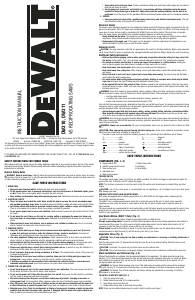

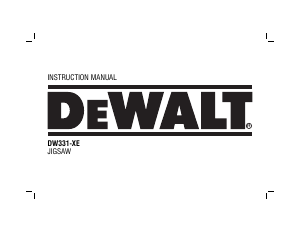
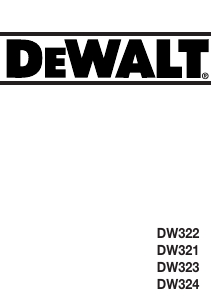



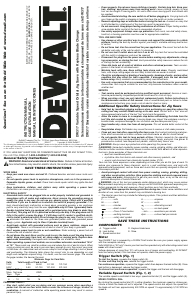

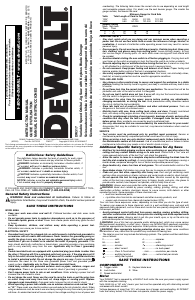
Join the conversation about this product
Here you can share what you think about the DeWalt DW310 Jigsaw. If you have a question, first carefully read the manual. Requesting a manual can be done by using our contact form.